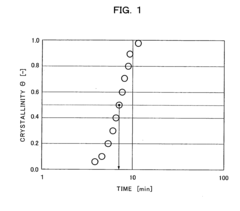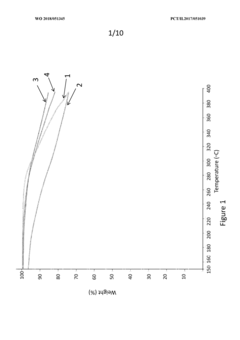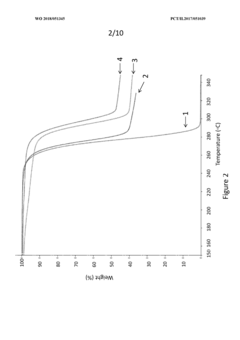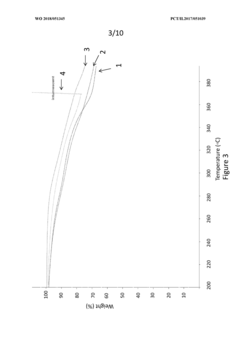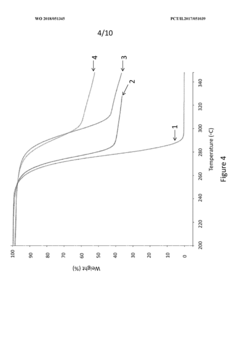Flame Retardant Biodegradable Plastics Innovations
Flame Retardant Bioplastics: Background and Objectives
Flame retardant biodegradable plastics represent a cutting-edge field at the intersection of materials science, environmental sustainability, and safety engineering. This innovative technology aims to address the growing global concern over plastic pollution while simultaneously enhancing fire safety in various applications. The development of these materials has gained significant momentum in recent years, driven by increasing environmental awareness and stringent safety regulations across industries.
The evolution of flame retardant biodegradable plastics can be traced back to the early 2000s when researchers began exploring ways to combine the biodegradability of certain polymers with flame-retardant properties. This technological convergence was sparked by the need to replace conventional petroleum-based plastics with more environmentally friendly alternatives, while also meeting the fire safety requirements of modern products and infrastructure.
The primary objective of research in this field is to create materials that can effectively resist ignition and slow down flame propagation, while also being capable of decomposing naturally in the environment within a reasonable timeframe. This dual functionality poses significant challenges, as the additives traditionally used for flame retardancy often hinder the biodegradation process or introduce toxic elements into the ecosystem.
Recent advancements have focused on developing novel flame retardant systems that are compatible with biodegradable polymer matrices. These include phosphorus-based compounds, nitrogen-containing additives, and inorganic fillers that can impart flame resistance without compromising the material's ability to biodegrade. Researchers are also exploring the potential of bio-based flame retardants derived from renewable resources, aligning with the overarching goal of sustainability.
The technological trajectory in this domain is aimed at optimizing the balance between flame retardancy, biodegradability, and mechanical properties. Scientists and engineers are working towards creating materials that not only meet regulatory standards for fire safety but also decompose completely in various environmental conditions, leaving no harmful residues. This involves fine-tuning the chemical composition, exploring synergistic effects between different additives, and developing novel processing techniques.
As the field progresses, there is a growing emphasis on life cycle assessment and the overall environmental impact of these materials. The goal is to ensure that the production, use, and disposal of flame retardant biodegradable plastics result in a net positive effect on the environment compared to traditional plastics. This holistic approach encompasses considerations such as energy consumption during manufacturing, toxicity of additives, and the speed and completeness of biodegradation in different ecosystems.
Market Analysis for Eco-friendly Flame Retardant Materials
The market for eco-friendly flame retardant materials has experienced significant growth in recent years, driven by increasing environmental concerns and stringent regulations on traditional flame retardants. This segment of the flame retardant industry is poised for continued expansion as manufacturers and consumers alike seek sustainable alternatives that maintain fire safety standards while reducing environmental impact.
The global eco-friendly flame retardant market is primarily segmented into halogen-free flame retardants and bio-based flame retardants. Halogen-free options, such as phosphorus-based and nitrogen-based compounds, have gained traction due to their lower toxicity and reduced smoke production during combustion. Bio-based flame retardants, derived from renewable resources like plant oils and starches, are emerging as promising alternatives, aligning with the circular economy principles.
Key industries driving the demand for eco-friendly flame retardants include construction, electronics, automotive, and textiles. The construction sector, in particular, has shown robust growth in adopting these materials, especially in insulation and building materials. The electronics industry is also a significant consumer, driven by the need for fire-safe components in consumer electronics and data centers.
Geographically, Europe leads the market for eco-friendly flame retardants, owing to its strict regulatory environment and high consumer awareness. North America follows closely, with increasing adoption in various industries. The Asia-Pacific region is expected to witness the fastest growth, fueled by rapid industrialization and growing environmental consciousness in countries like China and India.
Consumer preferences are shifting towards products with reduced environmental footprint, creating opportunities for eco-friendly flame retardants in consumer goods. This trend is particularly evident in the furniture and home textile sectors, where fire safety regulations intersect with sustainability concerns.
Challenges in the market include the higher cost of eco-friendly alternatives compared to traditional flame retardants and the need for extensive research and development to improve their performance. However, ongoing technological advancements and economies of scale are gradually addressing these issues, making eco-friendly options more competitive.
The market is characterized by intense research activities focused on developing novel, sustainable flame retardant solutions. Collaborations between academic institutions and industry players are accelerating innovation in this field, leading to the introduction of new bio-based and nanocomposite flame retardants with enhanced properties.
Current Challenges in Biodegradable Flame Retardant Plastics
The development of biodegradable flame retardant plastics faces several significant challenges that hinder widespread adoption and commercialization. One of the primary obstacles is achieving a balance between flame retardancy and biodegradability. Many conventional flame retardants used in plastics are not biodegradable, and their incorporation can significantly reduce the overall biodegradability of the material.
Another major challenge is maintaining the mechanical properties of biodegradable plastics while incorporating flame retardant additives. The addition of flame retardants often leads to a decrease in tensile strength, impact resistance, and other crucial mechanical characteristics. This trade-off between flame retardancy and material performance limits the application range of these materials in various industries.
The cost-effectiveness of biodegradable flame retardant plastics remains a significant hurdle. The production of these materials often involves complex processes and expensive additives, resulting in higher costs compared to conventional plastics. This price differential makes it difficult for biodegradable flame retardant plastics to compete in price-sensitive markets.
Environmental concerns also pose challenges in the development of these materials. While biodegradability is a desirable trait, some flame retardant additives may release harmful substances during degradation or combustion. Ensuring that the breakdown products are environmentally benign is crucial for the long-term sustainability of these materials.
Regulatory compliance presents another obstacle. Different regions have varying standards and regulations regarding flame retardancy and biodegradability. Meeting these diverse requirements while maintaining material performance and cost-effectiveness is a complex task for manufacturers.
The lack of standardized testing methods for simultaneously evaluating biodegradability and flame retardancy is another challenge. This absence of unified testing protocols makes it difficult to compare different materials and validate their performance across various applications and environments.
Scalability and processability issues also persist in the production of biodegradable flame retardant plastics. Many promising formulations developed in laboratories face difficulties when scaled up to industrial production levels. Ensuring consistent quality and performance in large-scale manufacturing remains a significant challenge.
Existing Flame Retardant Solutions for Biodegradable Plastics
01 Incorporation of flame retardant additives
Flame retardant additives are incorporated into biodegradable plastics to enhance their fire resistance properties. These additives can include halogenated compounds, phosphorus-based materials, or inorganic fillers. The additives work by interfering with the combustion process, either by releasing flame-inhibiting gases or by forming a protective char layer.- Incorporation of flame retardant additives: Flame retardant additives are incorporated into biodegradable plastics to enhance their fire resistance properties. These additives can include halogenated compounds, phosphorus-based materials, or inorganic fillers. The additives work by interfering with the combustion process, reducing the spread of flames, or forming a protective char layer.
- Use of biodegradable polymers with inherent flame retardancy: Some biodegradable polymers possess inherent flame retardant properties due to their chemical structure. These polymers can be used as the base material for flame retardant biodegradable plastics, reducing the need for additional flame retardant additives. Examples include certain polyesters and polyphosphazenes.
- Surface treatment and coating techniques: Surface treatments and coatings can be applied to biodegradable plastics to improve their flame retardancy. These techniques involve applying a flame retardant layer on the surface of the plastic, which can provide protection against ignition and flame spread. Methods may include plasma treatment, chemical vapor deposition, or application of flame retardant coatings.
- Nanocomposite approach for flame retardancy: Nanocomposites are developed by incorporating nanoscale flame retardant materials into biodegradable polymer matrices. This approach can significantly enhance the flame retardant properties of the plastic while maintaining its biodegradability. Common nanofillers include clay particles, carbon nanotubes, and metal oxide nanoparticles.
- Synergistic combinations of flame retardants: Combining different types of flame retardants can create synergistic effects, enhancing the overall flame retardancy of biodegradable plastics. These combinations may include mixtures of organic and inorganic flame retardants, or intumescent systems that form a protective char layer when exposed to heat. The synergistic approach allows for lower overall additive loadings while maintaining effective flame retardancy.
02 Use of bio-based flame retardants
Bio-based flame retardants derived from renewable resources are used to improve the flame retardancy of biodegradable plastics. These environmentally friendly additives can include modified natural polymers, plant-based compounds, or bio-derived phosphorus materials. They offer a sustainable alternative to traditional petroleum-based flame retardants while maintaining biodegradability.Expand Specific Solutions03 Polymer blending for improved flame retardancy
Blending different biodegradable polymers or incorporating flame-resistant polymers into biodegradable plastics can enhance overall flame retardancy. This approach allows for the synergistic effects of different materials, potentially reducing the need for additional flame retardant additives while maintaining biodegradability.Expand Specific Solutions04 Surface treatments and coatings
Applying flame retardant surface treatments or coatings to biodegradable plastics can improve their fire resistance without significantly altering the bulk properties of the material. These treatments can include thin layers of inorganic compounds or flame-resistant polymers that provide a protective barrier against fire.Expand Specific Solutions05 Nanocomposite approach
Incorporating nanoparticles or nanostructures into biodegradable plastics can significantly enhance their flame retardancy. These nanocomposites can include clay minerals, carbon nanotubes, or metal oxide nanoparticles. The nanoparticles create a barrier effect, reducing heat transfer and improving the overall fire resistance of the material.Expand Specific Solutions
Key Players in Flame Retardant Bioplastics Industry
The research on flame retardant biodegradable plastics innovations is in a nascent stage, with significant growth potential. The market is expanding rapidly due to increasing environmental concerns and stringent regulations. While the technology is still evolving, several key players are making strides in this field. Companies like BASF SE, Mitsubishi Plastics, Inc., and Unitika Ltd. are at the forefront, leveraging their expertise in materials science. Academic institutions such as Zhejiang University and South China University of Technology are contributing to fundamental research. The involvement of diverse entities, including Sony Group Corp. and Stratasys, Inc., indicates a growing interest across various industries. However, the technology's maturity varies, with some players focusing on improving existing solutions while others explore novel approaches to balance flame retardancy and biodegradability.
Mitsubishi Plastics, Inc.
Unitika Ltd.
Core Innovations in Flame Retardant Bioplastic Research
- A biodegradable polyester resin composition incorporating a (meth)acrylate compound and a metal oxide or metal hydroxide, combined through melt-mixing with a peroxide, to enhance flame retardancy, mechanical strength, and moldability while maintaining biodegradability.
- A biodegradable composite material comprising a lignin-based compound, an aldehyde, an amine-containing compound, and ammonium polyphosphate (APP) is developed, which provides a synergistic intumescent effect, is chemically stable, and can be incorporated into plastics without compromising mechanical properties, utilizing a straightforward preparation process.
Environmental Impact and Life Cycle Assessment
The development of flame retardant biodegradable plastics presents a complex interplay between environmental benefits and potential drawbacks. Life cycle assessment (LCA) studies have shown that these innovative materials can significantly reduce the carbon footprint associated with traditional plastics production and disposal. The biodegradability aspect ensures that these plastics break down naturally in the environment, potentially mitigating the long-term accumulation of plastic waste in ecosystems.
However, the environmental impact of flame retardant additives in biodegradable plastics requires careful consideration. Some flame retardants may leach into the environment during the degradation process, potentially causing soil or water contamination. Research has indicated that certain halogenated flame retardants can persist in the environment and bioaccumulate in food chains, raising concerns about long-term ecological effects.
The production phase of flame retardant biodegradable plastics also warrants scrutiny. While the use of renewable resources for bioplastic production can reduce reliance on fossil fuels, intensive agricultural practices for feedstock cultivation may lead to increased land use, water consumption, and potential habitat disruption. Additionally, the energy requirements and chemical processes involved in incorporating flame retardant properties into biodegradable plastics may offset some of the environmental gains achieved through biodegradability.
End-of-life management presents both opportunities and challenges for these materials. Proper composting facilities can effectively process biodegradable plastics, returning nutrients to the soil. However, the presence of flame retardants may complicate this process, potentially affecting compost quality or requiring specialized treatment methods. Recycling of flame retardant biodegradable plastics also poses technical challenges, as the additives may interfere with established recycling streams for conventional plastics.
LCA studies have highlighted the importance of considering regional factors in assessing the environmental impact of these materials. The availability of appropriate waste management infrastructure, local energy mix, and specific application scenarios can significantly influence the overall environmental performance of flame retardant biodegradable plastics.
Recent innovations in this field have focused on developing more environmentally benign flame retardants and improving the compatibility between flame retardant additives and biodegradable polymer matrices. These advancements aim to enhance the overall sustainability profile of the materials while maintaining their functional properties. Ongoing research is also exploring the potential for bio-based flame retardants derived from renewable sources, which could further align with circular economy principles and reduce the environmental footprint of these innovative plastics.
Regulatory Framework for Flame Retardant Bioplastics
The regulatory framework for flame retardant bioplastics is a complex and evolving landscape that plays a crucial role in shaping the development and adoption of these innovative materials. As the demand for sustainable and fire-resistant plastics grows, governments and regulatory bodies worldwide are working to establish comprehensive guidelines and standards to ensure safety, environmental protection, and product performance.
In the United States, the Environmental Protection Agency (EPA) and the Consumer Product Safety Commission (CPSC) are the primary regulatory bodies overseeing flame retardant bioplastics. The EPA's Toxic Substances Control Act (TSCA) regulates the production and use of chemical substances, including flame retardants, while the CPSC enforces flammability standards for various consumer products. These agencies work in tandem to assess the safety and environmental impact of flame retardant bioplastics throughout their lifecycle.
The European Union has implemented the Registration, Evaluation, Authorization, and Restriction of Chemicals (REACH) regulation, which governs the use of chemical substances, including those used in flame retardant bioplastics. Additionally, the EU's Restriction of Hazardous Substances (RoHS) Directive limits the use of certain hazardous substances in electrical and electronic equipment, further influencing the development of flame retardant bioplastics for these applications.
International standards organizations, such as the International Organization for Standardization (ISO) and ASTM International, have developed specific standards for testing and certifying flame retardant bioplastics. These standards ensure consistency in performance evaluation and provide a common language for manufacturers, regulators, and consumers to assess product quality and safety.
As the field of flame retardant biodegradable plastics continues to evolve, regulatory frameworks are adapting to address new challenges and opportunities. Many countries are implementing stricter regulations on traditional flame retardants due to environmental and health concerns, driving the need for more sustainable alternatives. This regulatory pressure is spurring innovation in the development of bio-based flame retardants and environmentally friendly fire-resistant bioplastics.
The regulatory landscape also encompasses end-of-life considerations for flame retardant bioplastics. Biodegradability and compostability standards are being integrated into existing frameworks to ensure that these materials can be safely and effectively disposed of without causing environmental harm. This holistic approach to regulation aims to create a circular economy for flame retardant bioplastics, from production to disposal.
